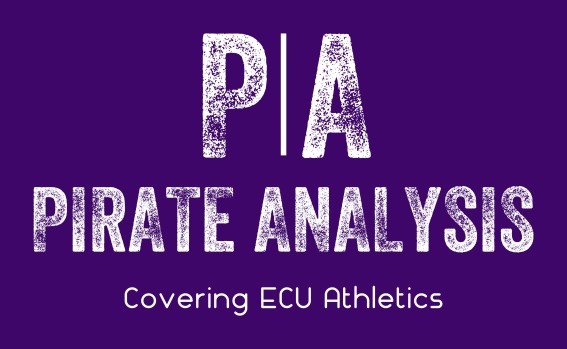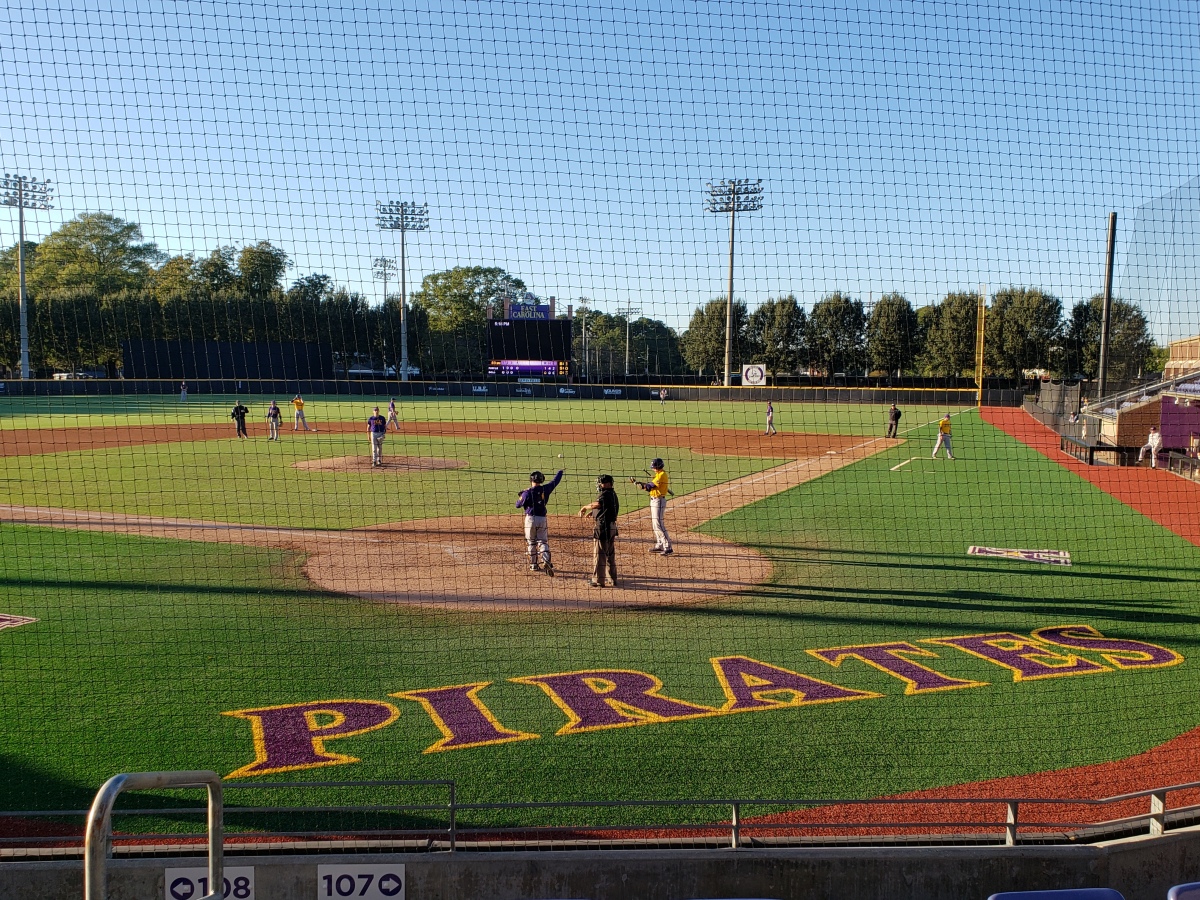College baseball could be getting a facelift in the next couple of years thanks to a proposal being put together by some prominent skippers from around the country. Former East Carolina University baseball player and current head baseball coach at Michigan Erik Bakich is the key force behind what is being called the “New Baseball Model.”
Bakich’s former Pirate teammate and current ECU skipper Cliff Godwin has also been giving input to the idea as an attempt is being made to reach all 299 college baseball coaches for their thoughts and suggestions on the topic.
“Really the thing I commend Erik for is nobody told him to do this,” Godwin told Patrick Johnson on 94.3 The Game on Wednesday. “It’s not for his self benefit. Of course, it would benefit teams, on just the surface, that play in colder temperatures. The thing Erik has done from day one is he’s reached out to southern coaches, he’s reached out to coaches on the West Coast, he’s reached out to coaches nationally to ask them questions about how this would look within their baseball program.”
The proposal, which is a 35-page document and wants to push the season back a month, essentially has three parts: financial sustainability for collegiate baseball programs, student-athlete welfare and academic success for those students.
“College baseball currently operates at a significant financial net loss,” Bakich said. “You pair that with the higher education that are facing a financial crisis at this current time and we just need to make some adjustments to be more financially sustainable, to improve our bottom line.”
According to the proposal, which can be found at D1Baseball.com (subscription required), a sample season would look something like this:
Jan. 15-Feb. 10: 8-hour CARA (countable athletically related activities) period (four weeks)
Feb. 11-March 20: 20-hour CARA period (5 weeks)
March 18: College baseball season begins (14 weeks)
June 22-26: Conference tournaments
July 1-4: NCAA Regionals
July 8-10: NCAA Super Regionals
July 15: College World Series begins
July 23-25: National Championship series
The extra time during the preseason would give college baseball teams nine weeks of “ramp-up” time to get their players ready for the season, an increase over the five weeks currently allowed by the NCAA.
According to the proposal, which dives into the increase in injuries during the early portions of the season, received input from esteemed surgeon Dr. James Andrews on the matter. The thought is that with increased preparation time for players, particularly pitchers, injuries would be significantly impacted in a positive manner.
“You look at our calendar this past year,” Godwin said. “Our first day of school was Jan. 13, our first day of practice was Jan. 24. Well on the first day of official team practice, you’re scrimmaging, so you have really 11 days of individual workouts but you only have two hours per week and then you’re ramping up to scrimmage 11 days later. Then three weeks later, you’re playing William & Mary….What sport is off for four to five weeks and then you’re asking them basically to play a month after they step foot back on campus?”
While there’s little doubt increased ramp-up time would cut down on injuries, the proposal also tackles another important problem that plagues college baseball: financial sustainability.
The Athletics Fiscal Sustainability Working Group Report put together by ECU administrators and published earlier this month shows ECU baseball operated at a loss around $1 million for fiscal year 2019. That trend is not exclusive to ECU as the vast majority of baseball programs around the country find themselves, more often than not, operating in the red.
“With the exception of a few schools, college baseball just operates at such a significant financial net loss and you look at the start of the season as being a reason why,” Bakich said. “The general baseball fan just doesn’t turn their attention to baseball until it’s baseball season and most people associate baseball season with when the major league season starts and that’s in April.”
The report found that the majority of college baseball teams drew more fans in April and May than colder weather months like February and March. In ECU’s case, they saw a 19% increase in average fan attendance from March 2019 to April 2019 and a 44% jump from May to June of the same year, according to the report.
Again, that trend is not lost when you expand the research to most postseason hosts dating back to 2017. Under this proposal, teams would play the majority of their home games in April and May, and be largely free from the college basketball season and colder temperatures.
“Taking the perspective of the warm weather teams and seeing if this makes sense for them,” Bakich said. “We know there’s going to be some benefits for the cold weather teams, but how does this impact the warm weather teams? That’s where we’ve really, to keep with the financial theme, seen that it doesn’t make any financial sense to play college baseball starting on Valentine’s Day playing in February and early March.”
For cold weather teams, that is teams like Bakich’s Michigan and others from the Northeast, pushing the season back to a mid-March start date would allow them to schedule more home games during the early portions of the season. That, in turn, cuts down on travel expenses for teams that essentially live on the road during the first month or so of the campaign.
In the report, the average travel expenses during the season’s first four weeks and last four weeks for a Big Ten baseball program are broken down. The five-year average cost for the initial four weeks of a season that includes many trips on a commercial airplane sits at north of $230,000. Conversely, the last four weeks figure for the same five-year average is just under $89,000 and includes mostly regionalized bus travel.
With colder climate teams able to play more home games at the beginning of the season, warmer weather teams would not be relegated to paying guarantees for those clubs to come South. Additionally, it frees up all teams to schedule more regional play, a notion that is getting more attention due to the impacts of COVID-19.
“We all know in the post-COVID era, all athletic departments want more regionalized play,” Bakich said. “Travel budgets are inflated, not just in baseball but in all of college athletics and if you can promote more regionalized play, that’s a significant saver of money. So this proposal aligns with that.”
At ECU, the largest crowd ever assembled at Clark-LeClair Stadium came against a regional opponent in the University of North Carolina back in 2009. More recently, however, the Pirates played UNC in a three-game series during the second weekend of the 2018 campaign. One game was played in Greenville, the other was played in Durham and Sunday’s matchup was at UNC’s home ballpark.
“Now the weather turned out to be awesome so we sold out on Friday night here in Greenville, we had close to 7,000 in the Triple-A park in Durham and we made $25,000-27,000 as an athletic department,” Godwin said. “We took one-third of the profit, Carolina took one-third of the profit and the Durham Bulls took one-third of the profit.
“I think that would go to show you how, at least in the Carolinas, if you’re doing more regional scheduling a month later where weather was going to be good, and you’re playing three-game series with a Carolina, a NC State, a UVA, a UNCW, then that’s the type of financial gain you could grab there.”
With regionalized play either in the season, student-athletes would also be afforded the opportunity to attend more classes. In colder climates and with teams traveling constantly, the proposal suggests student-athletes miss an average of 14 class days, a number that could be potentially cut to four under the new model.
Of course, operating budgets and expenses are different with just about every program. Nevertheless, Bakich said even with the increased home games of colder climate teams and extra four weeks to the season, net gains could be in the $60,000 to $75,000 range. The proposal also states that figure does not include “revenue generated from increased ‘actual’ attendance.”
“College baseball budgets differ at various schools but when you’re talking about starting to have a surplus in the tens of thousands compared to what you were operating at before, that is a significant amount of money,” Bakich said.
While this new model is gaining steam from coaches and administrators around the country, it still has a long road to being implemented.
“We’re rallying the coaches,” Bakich said. “In any legislative proposal if it is to be voted on by the D1 Council, first you have to have support from the coaches and the conference levels. Usually legislation is proposed by one conference or one school and then it gets sponsored and then it moves to athletic directors, facility athletics reps before it ends up at the D1 Council to be voted on.”
If and when it is put into action, the new model could completely reshape the financial structure of collegiate baseball and put it on the path toward becoming a revenue-generating sport at more schools around the country.
Listen to the full interview between Patrick Johnson, Cliff Godwin and Erik Bakich that orginially aired on 94.3 The Game on Wednesday below:
Part 1 –
Part 2 –

